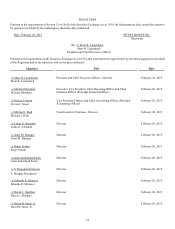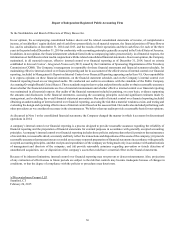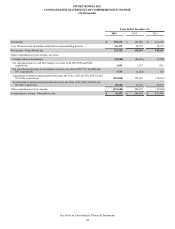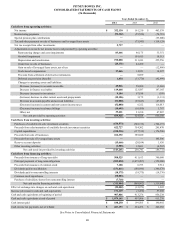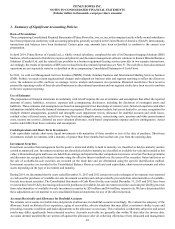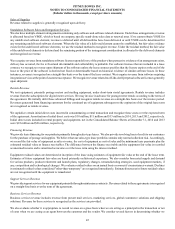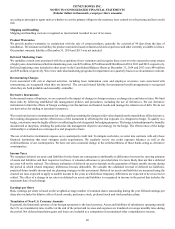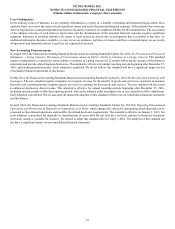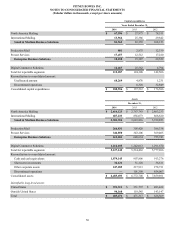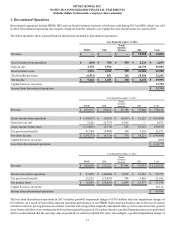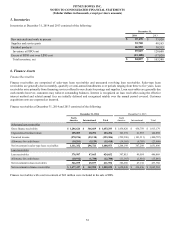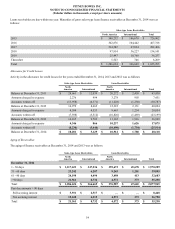Pitney Bowes 2014 Annual Report Download - page 54
Download and view the complete annual report
Please find page 54 of the 2014 Pitney Bowes annual report below. You can navigate through the pages in the report by either clicking on the pages listed below, or by using the keyword search tool below to find specific information within the annual report.
PITNEY BOWES INC.
NOTES TO CONSOLIDATED FINANCIAL STATEMENTS
(Tabular dollars in thousands, except per share amounts)
44
carrying amount, an impairment charge is recorded for an amount by which the carrying amount exceeds the fair value of the asset. The
fair value of the impaired asset is determined using probability weighted expected cash flow estimates, quoted market prices when
available and appraisals, as appropriate. We derive cash flow estimates from our long-term business plans and historical experience.
Impairment Review for Goodwill
Goodwill is tested annually for impairment at the reporting unit level during the fourth quarter or sooner when circumstances indicate
an impairment may exist. A reporting unit is the operating segment, or a business that is one level below that operating segment. Reporting
units are aggregated as a single reporting unit if they have similar economic characteristics. Goodwill is tested for impairment using a
two-step approach. In the first step, the fair value of each reporting unit is determined and compared to the reporting unit's carrying value,
including goodwill. If the fair value of a reporting unit is less than its carrying value, the second step of the goodwill impairment test is
performed to measure the amount of impairment, if any. In the second step, the fair value of the reporting unit is allocated to the assets
and liabilities of the reporting unit as if it had been acquired in a business combination and the purchase price was equivalent to the fair
value of the reporting unit. The excess of the fair value of the reporting unit over the amounts assigned to its assets and liabilities is
referred to as the implied fair value of goodwill. The implied fair value of the reporting unit's goodwill is then compared to the actual
carrying value of goodwill. If the implied fair value of goodwill is less than the carrying value of goodwill, an impairment loss is recognized
for the difference. The fair value of a reporting unit is determined based on a combination of various techniques, including the present
value of future cash flows, multiples of competitors and multiples from sales of like businesses.
Retirement Plans
Net periodic benefit cost includes current service cost, interest cost, expected return on plan assets and the amortization of actuarial gains
and losses. Actuarial gains and losses arise from actual experiences that differ from previous assumptions as well as changes in assumptions
including expected return on plan assets, discount rates used to measure pension and other postretirement obligations and life expectancy.
The expected return on assets is measured using the market-related value of assets, which is a calculated value that recognizes changes
in the fair value of plan assets over 5 years. Actuarial gains and losses are recognized in accumulated other comprehensive loss, net of
tax and amortized to benefit cost over the life expectancy of inactive plan participants. We recognize the funded status of pension and
other postretirement benefit plans in the Consolidated Balance Sheets.
Stock-based Compensation
We measure compensation expense for stock-based awards based on the estimated fair value of the awards expected to vest (net of
estimated forfeitures) and recognize the expense on a straight-line basis over the employee requisite service period. We estimate the fair
value of stock awards using a Black-Scholes valuation model or a Monte Carlo simulation model for those awards that contain a market
condition. We believe that the valuation techniques and the approach utilized to develop the underlying assumptions are appropriate in
estimating the fair value of our stock awards. Estimates of fair value are not intended to predict actual future events or the value ultimately
realized by employees and subsequent events are not indicative of the reasonableness of the original estimates of fair value.
Revenue Recognition
We derive revenue from multiple sources including sales, rentals, financing and services. Certain transactions are consummated at the
same time and can therefore generate revenue from multiple sources. The most common form of these transactions involves a sale or
non-cancelable lease of equipment, a meter rental and an equipment maintenance agreement. In these multiple element arrangements,
revenue is allocated to each of the elements based on relative "selling prices" and the selling price for each of the elements is determined
based on vendor specific objective evidence (VSOE). We establish VSOE of selling prices for our products and services based on the
prices charged for each element when sold separately in standalone transactions. The allocation of relative selling price to the various
elements impacts the timing of revenue recognition, but does not change the total revenue recognized. Revenue is allocated to the meter
rental and equipment maintenance agreement elements using their respective selling prices charged in standalone and renewal transactions.
For a sale transaction, revenue is allocated to the equipment based on a range of selling prices in standalone transactions. For a lease
transaction, revenue is allocated to the equipment based on the present value of the remaining minimum lease payments. The amount
allocated to equipment is compared to the range of selling prices in standalone transactions during the period to ensure the allocated
equipment amount approximates average selling prices. More specifically, revenue related to our offerings is recognized as follows:
Sales Revenue
Sales of Equipment
We sell equipment directly to our customers and to distributors (re-sellers) throughout the world. We recognize revenue from these sales
when the risks and rewards of ownership transfer to the customer, which is generally upon shipment or acceptance by the customer. We
recognize revenue from the sale of equipment under sales-type leases as equipment sales revenue at the inception of the lease. We do not
typically offer any rights of return or stock balancing rights. Sales revenue from customized equipment, mail creation equipment and
shipping products is generally recognized when installed.


